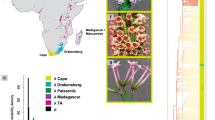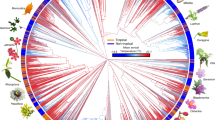Abstract
Patterns seen in other Australian flora have led to hypotheses that early Miocene shifts in climate drove rapid radiation of major taxonomic groups such as Eucalyptus. Little is known about absolute dates and rates for Australian monocots, particularly grasses. I tested this early Miocene radiation hypothesis for Australian grasses using a calibrated phylogeny of the endemic stipoid genus Austrostipa and an analysis of diversification rates. The phylogeny was developed from a Bayesian likelihood analysis of the nuclear internal transcribed spacers region, and three calibration points were set based on fossil evidence. The results indicate that the genus arose in the early Miocene and underwent a species radiation, but the rate of diversification was not rapid compared to the current rate or to those of other taxa. Following an 8 million year period of fast molecular evolution but no taxonomic radiation, diversification rates have been constant for the past 15 million years. Comparable measures such as the gamma statistic can be used across taxa to make general conclusions about evolutionary rate constancy.


Similar content being viewed by others
References
Bendiksby M, Schumacher T, Gussarova G, Nais J, Mat-Salleh K, Sofiyanti N, Madulid D, Smith SA, Barkman T (2010) Elucidating the evolutionary history of the Southeast Asian, holoparasitic, giant-flowered Rafflesiaceae: Pliocene vicariance, morphological convergence and character displacement. Mol Phylogenet Evol 57(2):620–633. doi:10.1016/j.ympev.2010.08.005
Bouchenak-Khelladi Y, Salamin N, Savolainen V, Forest F, Mvd Bank, Chase MW, Hodkinson TR (2008) Large multi-gene phylogenetic trees of the grasses (Poaceae): progress towards complete tribal and generic level sampling. Mol Phylogenet Evol 47(2):488–505. doi:10.1016/j.ympev.2008.01.035
Bouchenak-Khelladi Y, Verboom GA, Savolainen V, Hodkinson TR (2010) Biogeography of the grasses (Poaceae): a phylogenetic approach to reveal evolutionary history in geographical space and geological time. Bot J Linn Soc 162(4):543–557. doi:10.1111/j.1095-8339.2010.01041.x
Bremer K (2002) Gondwanan evolution of the grass alliance of families (Poales). Evolution 56(7):1374–1387
Cerling TE, Harris JM, MacFadden BJ, Leakey MG, Quade J, Eisenmann V, Ehleringer JR (1997) Global vegetation change through the Miocene/Pliocene boundary. Nature 389(6647):153–158
Cialdella AM, Salariato DL, Aagesen L, Giussani LM, Zuloaga FO, Morrone O (2010) Phylogeny of new world Stipeae (Poaceae): an evaluation of the monophyly of Aciachne and Amelichloa. Cladistics 26:1–16. doi:10.1111/j.1096-0031.2010.00310.x
Crepet WL, Feldman GD (1991) The earliest remains of grasses in the fossil record. Am J Bot 78(7):1010–1014
Crisp MD, Cook LG (2009) Explosive radiation or cryptic mass extinction? Interpreting signatures in molecular phylogenies. Evolution 63(9):2257–2265. doi:10.1111/j.1558-5646.2009.00728.x
Crisp M, Cook L, Steane D (2004) Radiation of the Australian flora: what can comparisons of molecular phylogenies across multiple taxa tell us about the evolution of diversity in present-day communities? Philos Trans R Soc Lond B 359:1551–1571
Drummond A, Rambaut A (2007) BEAST: Bayesian evolutionary analysis by sampling trees. BMC Evol Biol 7:214
Drummond AJ, Ho SYW, Phillips MJ, Rambaut A (2006) Relaxed phylogenetics and dating with confidence. PLoS Biol 4(5):e88
Drummond A, Ho S, Rawlence N, Rambaut A (2007) A Rough Guide to BEAST 1.4. www.beast.bio.ed.ac.uk
Edgar RC (2004) MUSCLE: multiple sequence alignment with high accuracy and high throughput. Nucleic Acids Res 32(5):1792–1797. doi:10.1093/nar/gkh340
Edwards EJ, Smith SA (2010) Phylogenetic analyses reveal the shady history of C4 grasses. Proc Nat Acad Sci 107(6):2532–2537. doi:10.1073/pnas.0909672107
Edwards EJ, Still CJ (2008) Climate, phylogeny and the ecological distribution of C4 grasses. Ecol Lett 11(3):266–276. doi:10.1111/j.1461-0248.2007.01144.x
Forest F (2009) Calibrating the tree of life: fossils, molecules and evolutionary timescales. Ann Bot 104(5):789–794. doi:10.1093/aob/mcp192
Harmon LJ, Weir JT, Brock CD, Glor RE, Challenger W (2008) GEIGER: investigating evolutionary radiations. Bioinformatics 24(1):129–131. doi:10.1093/bioinformatics/btm538
Ho SYM (2007) Calibrating molecular estimates of substitution rates and divergence times in birds. J Avian Biol 38(4):409–414. doi:10.1111/j.0908-8857.2007.04168.x
Ho SYW, Phillips MJ (2009) Accounting for calibration uncertainty in phylogenetic estimation of evolutionary divergence times. Syst Biol 58(3):367–380. doi:10.1093/sysbio/syp035
Hsiao C, Jacobs SWL, Chatterton NJ, Asay KH (1999) A molecular phylogeny of the grass family (Poaceae) based on the sequences of nuclear ribosomal DNA (ITS). Aust Syst Bot 11:667–688
Jones R (1997) The biogeography of the grasses and lowland grasses of south-eastern Australia. Adv Nat Conserv 2:11–18
Kay K, Whittall J, Hodges S (2006) A survey of nuclear ribosomal internal transcribed spacer substitution rates across angiosperms: an approximate molecular clock with life history effects. BMC Evol Biol 6(1):36
Kellogg EA (2000) The grasses: a case study in macroevolution. Annu Rev Ecol Syst 31(1):217–238. doi:10.1146/annurev.ecolsys.31.1.217
Lancaster L (2010) Molecular evolutionary rates predict both extinction and speciation in temperate angiosperm lineages. BMC Evol Biol 10(1):162
Lawver LA, Gahagan LM (2003) Evolution of Cenozoic seaways in the circum-Antarctic region. Palaeogeogr Palaeoclimatol Palaeoecol 198(1–2):11–37. doi:10.1016/s0031-0182(03)00392-4
Linder HP (1987) The evolutionary history of the Poales/Restionales—a hypothesis. Kew Bull 42:297–318
Linder HP (2008) Plant species radiations: where, when, why? Philos Trans R Soc B Biol Sci 363(1506):3097–3105. doi:10.1098/rstb.2008.0075
Macphail MK, Hill RS (2002) Paleobotany of the Poaceae. In: Mallett K (ed) Flora of Australia, vol 43. Australian Biological Resources Study/CSIRO Publishing, pp 37–70
Magallon S, Castillo A (2009) Angiosperm diversification through time. Am J Bot 96(1):349–365. doi:10.3732/ajb.0800060
Martin HA (2006) Cenozoic climatic change and the development of the arid vegetation in Australia. J Arid Environ 66(3):533–563. doi:10.1016/j.jaridenv.2006.01.009
McCusker A (2002) Poaceae: family description. In: Mallett K (ed) Flora of Australia, vol 43. Australian Biological Resources Study/CSIRO Publishing, pp 1–3
Paradis E, Claude J, Strimmer K (2004) APE: analyses of phylogenetics and evolution in R language. Bioinformatics 20(2):289–290. doi:10.1093/bioinformatics/btg412
Posada D, Crandall KA (1998) MODELTEST: testing the model of DNA substitution. Bioinformatics 14(9):817–818. doi:citeulike-article-id:2306418
Prasad V, Stromberg CAE, Alimohammadian H, Sahni A (2005) Dinosaur coprolites and the early evolution of grasses and grazers.(Reports). Science 310(5751):1177–1180
Prothero DR (1994) The late Eocene–Oligocene extinctions. Annu Rev Earth Planet Sci 22(1):145–165. doi:10.1146/annurev.ea.22.050194.001045
Pybus OG, Harvey PH (2000) Testing macro-evolutionary models using incomplete molecular phylogenies. Proc Biol Sci 267(1459):2267–2272
Rambaut A (2009) FigTree version 1.3.1. http://tree.bio.ed.ac.uk/software/figtree
Rambaut A, Drummond A (2007) TRACER v1.4, Available from http://beast.bio.ed.ac.uk/Tracer
Romaschenko K, Peterson PM, Soreng RJ, Garcia-Jacas N, Susanna A (2010) Phylogenetics of Stipeae (Poaceae: Pooidae) based on plastid and nuclear DNA sequences. In: Seberg O, Petersen G, Barfod A, Davis J (eds) Diversity, phylogeny and evolution in the monocotyledons. Aarhus University Press, Aarhus
Sandve SR, Fjellheim S (2010) Did gene family expansions during the Eocene–Oligocene boundary climate cooling play a role in Pooidae adaptation to cool climates? Mol Ecol 19:2075–2088
Schneider J, Winterfeld G, Hoffmann MH, Roser M (2011) Duthieeae, a new tribe of grasses (Poaceae) identified among the early diverging lineages of subfamily Pooideae: molecular phylogenetics, morphological delineation, cytogenetics and biogeography. Syst Biodivers 9(1):27–44. doi:10.1080/14772000.2010.544339
Stromberg CAE (2005) Decoupled taxonomic radiation and ecological expansion of open-habitat grasses in the Cenozoic of North America. Proc Nat Acad Sci 102(34):11980–11984
Stromberg CAE, McInerney FA (2011) The Neogene transition from C3 to C4 grasslands in North America: assemblage analysis of fossil phytoliths. Paleobiology 37(1):50–71. doi:10.1666/09067.1
Thomasson JR (2005) Berriochloa gabeli and Berriochloa huletti (Gramineae: Stipeae), two new grass species from the late Miocene ash hollow formation of Nebraska and Kansas. J Paleontol 79(1):185–199
Vicentini A, Barber JC, Aliscioni SS, Giussani LM, Kellogg EA (2008) The age of the grasses and clusters of origins of C4 photosynthesis. Glob Change Biol 14(12):2963–2977. doi:10.1111/j.1365-2486.2008.01688.x
Zachos J, Pagani M, Sloan L, Thomas E, Billups K (2001) Trends, rhythms, and aberrations in global climate 65 Ma to present. Science (New York, NY) 292(5517):686–693
Acknowledgments
I thank the staff at the National Herbarium of Victoria, Australia, for providing the sequence data for Austrostipa specimens and Frank Udovicic for comments on the draft of this paper.
Author information
Authors and Affiliations
Corresponding author
Rights and permissions
About this article
Cite this article
Syme, A.E. Diversification rates in the Australasian endemic grass Austrostipa: 15 million years of constant evolution. Plant Syst Evol 298, 221–227 (2012). https://doi.org/10.1007/s00606-011-0539-7
Received:
Accepted:
Published:
Issue Date:
DOI: https://doi.org/10.1007/s00606-011-0539-7




